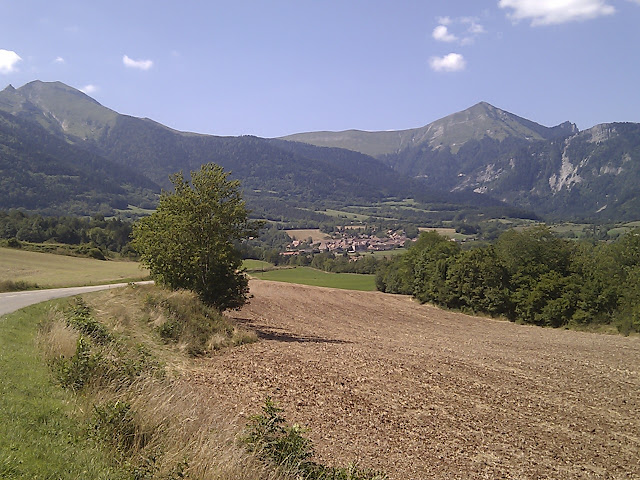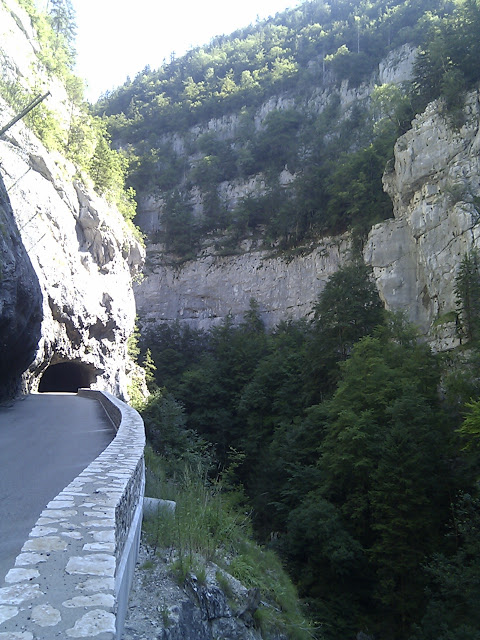Saturday, 31 August 2013
French road signage
But round here there is simply no need for GPS: the towns are not large, and more importantly, the signage is so good that a decent map and the signs are enough.
Firstly, the maps: though I've moaned about the paper quality, the IGN 1:100,000 series is ample for cycling, though their elevation data is a bit sparse, and you have to learn to read 'between the lines' if you don't want to get caught out with more climbing than you anticipated.
Then there's the signage round here - it's pretty comprehensive, once you know where you're going. Firstly, there are the general road signs, which always give distances and road numbers. (Note: occasionally a road will have two numbers, if two 'routes' share the same road, though there's only the Grenoble to Gap road round here that I can think of that does that.) Secondly there are the incredibly useful km markers along all but the smallest roads, that give distance from the starting point of the road, distance to the next place, and sometimes elevation and % gradient for the next kilometre. And lastly, there are the river and col signs that can confirm that you're definitely where you should be.
The point is that if you use a map and your senses you'll get a much better sense of the geography of wherever you are: not just the narrow strip on which you're riding, but also the rich landscape around you. And boy, there's some rich landscape round here.
Photos below come from today's southerly ride, down to Dieulefit, across to Trente Pas, and back up to return via the Roanne Valley. A pretty awesome ride, both physically and geographically.
Thursday, 29 August 2013
French fountains
Certainly in these parts it is unusual to pass through even a small settlement where you can't find some public source of 'Eau potable'. Indeed, it's so much the norm that it's pretty safe to assume that any water running into a trough in a village or town is 'potable' unless it specifically says it's not. (See photos below).
Having said that, I'm not sure how far south you have to come before that assumption is safe: last summer I got caught out by a fountain in some anonymous central French town, as I cycled from Exeter to Die (see how I sneaked that in there): it looked all the world like the examples down here, but I guess the slight green tinge should have alerted me. Well, the taste certainly did, and having spat it out, the nearby café provided water, but only after checking that I'd bought a coffee. Harumph.
The reference to washing wasn't entirely made for comic effect. I actually spoke briefly to an old lady in Sainte Croix (near Die) who was in the process of doing some washing in the trough. Which brings me to the bit of advice to fill your bottles direct from the piped water, unless you particularly enjoy the taste of old ladies' washing, and probably rampant French bacteria and parasites.
I'd be interested if anyone knows where the 'Eau potable' assumption is a safe one. All I know is that it's both reasonably safe, and very welcome down here.
Pictures below are of three examples from a ride today. Firstly a massive (40ft long!) trough in Cléon d'Andran, with a clear 'Eau non potable' sign; one from Bourdeaux (check the spelling), the 'Eau potable' sign probably there because there's another fountain just 50 yards away; and two examples from Saillans - the first is one of my favourites, as it's a good example of the attractive AND functional fountains you sometimes find.
Tuesday, 27 August 2013
Mad French roads: gorges.
The Gorges de la Bourne is one of those late 19th-century balcony roads that seemed to be as much about the problem-solving engineering as about the need to get from A to B. And I'm not sure what the economic case for building the Gorges des Gâts was (it was built in 1910) , and though it's maybe not a classic balcony road (much of it runs along the bottom of the gorge), it's certainly a roller-coaster ride. This time I rode there specially to take photos - I hope you appreciate the dedication to duty!
At the end of the photos there are a couple of shots from the ride back, and an apparently unloved little col: the Col de Miscon. No official sign there, but a rather sad little hand-painted one. OK, a 1023m col in these parts is hardly worth mentioning, but given that it's not far off the highest point in England, I thought I'd give it a little moment of glory. Well, if a paragraph in some barely-read blog can achieve that, that is.
Sunday, 25 August 2013
Diois weather
Well, at the risk of sounding a little morbid, I occasionally muse on how many summers I've got left in which I can make good use of the reasonably fit and active body I'm fortunate enough to have. Will I be able and keen to go up Alpe d'Huez in my seventies? Possibly yes, but I'd rather be getting in the riding and general enjoyment of the outdoors now, in decent weather. And decent weather has been in short supply. (That's assuming that decent weather includes reasonable doses of sunshine and warmth - though I'll grant that it's not to everyone's taste.)
Anyway, back to Diois weather, and those fallible averages: on average, Die has the same amount of rain as Devon, but about 800 more hours of sunshine. Yep, 800. That's nearly 50% more. Even if you distrust statistics, that's likely to be noticeable. And so it was last summer, with both of my visits seeing plenty of sunshine, while Devon was suffering storms and flooding. Not to mention temperatures of 39C during the August stay.
"But," I hear you say, "if it's so sunny, how come they have as much rain as Devon?" Good question - I'm glad you asked. Well, if you've seen an Alpine storm, you'll know how. An "orage". Rain like you"ll rarely see in England, but seen regularly here, especially at certain times of the year.
Well, one was forecast yesterday, and it came. There was no missing it. Thunder rolling around for an hour, lightning flashes getting closer. Then suddenly the wind went mad for five minutes, and all the mountains disappeared behind a wall of rain. The wind stopped, but it carried on raining for an hour. Then it stopped, and warm sun came out and there were clear blue skies. Time for a quick ride. But the showers were still about, so time to close the shutters for the night. When it rains here, you understand why French houses have shutters. Incidentally, we'ce had two rainy days here so far in August. Most of the rest of the time it's been sunny. They're getting their 800 extra hours, it seems.
Only two photos: one post-thunderstorm during the snatched ride; the other, an incendiary evening sky.
Home alone - time to ride the bike, I think.
Well, after a memorable meal at L'Aubergerie at Barnave, an early departure the following morning for the Morrisons saw them load up the car and bikes and hit the road back to Blighty. They were the perfect guests, and the time flew by in a stream of riding, eating, the odd beer or two, and lots of card games. But now they had gone, and what to do?
Ride a bike, of course. I've covered a lot of the roads round here now, and though there's not a single duff one, and I'm happy to repeat any route, I'm still on the look-out for new roads and routes for me.
So, in the photos below you'll see photos from two new rides. The first started of with a familiar ride over the Col de la Croix and down the Gervanne Valley, but then I detoured on to Gigors, and its lovely elevated position, before heading back to Die via the main road - always good training for just pumping out the miles.
The second ride is another classic, I think. From Die I headed out over the 1454m Col de Menée, on the descent from which you get great views of the amazing Mont Aiguille. After Mens I returned via the Col de la Haute Croix and Col de Grimone. And the stunning extra is then the Gorges de Gats - unlike the Gorges de la Bourne, this road sits right at the bottom of a deep ravine, complete with tunnels. Sorry no photos of the Gorges though - but I'll be back there again, for sure.
A classic ride with James...
Mary, for her part, has had a ball, either on her walks with Jim, or bravely searching out ingredients in the aisles of Intermarché or at Die market, and not least using my French cookbook to create some classic dishes.
James too has been up to all sorts (including impressive amounts of reading and sleeping). I took it upon myself to get him into form for a big ride in the second week of their stay, and James, being the willing trainee, was well prepared for the big day.
It was a route I hadn't done before: after Col de Rousset and La Chapelle-en-Vercors, it was down to Pont-en-Royans for the epic climb up the Gorges de la Bourne. Wow! What a crazily stunning road! Constructed in 1871 to take people up to Villard-de-Lans, it is a quite outstanding road to ride: the photos in no way do it justice. It's a must-ride road if you're anywhere near. And as if that wasn't enough, the ride back through a lush and sunny Vercors plateau was like riding through some dreamland. AND THEN of course we had the descent from the Col de Rousset to come, where I managed to overtake a motorbike, car, and motorhome in one go and left them (and James, caught behind, sorry!) for dust. 97 miles, and undoubtedly a classic ride, if ever there was one.
Saturday, 24 August 2013
Heading further south...
The reason for the Valdrôme detour was to make my way to Lesches in time for the birthday picnic and fireworks. I've no idea how many years they've had this all-day festival (apparently it marks the end of the settled summer weather), but if you're into fireworks, it's a great show. So, picnic with Wessons and Morrisons was had, Clairette was drunk, and the fireworks thrilled, with a very definite final salvo.
Sorry, no fireworks photos (I was too busy going "ooh" and "aah"), but a few from the ride, and of Phil on his departure from my house, when he called in a few days later.
Cols, cols, cols...
However, France has a reputation for road quality which is with good foundation. Whether it's because the French pay more tax, or because the government pays nothing maintaining the toll motorway network (leaving more money for other roads), it's rare that you'll find a poorly-maintained road here. And once you get into the Diois (the area around Die) and Vercors region, the mix of terrain and road quality is an absolute joy.
One of the best aspects is that you can make up a ride from virtually pan-flat (the Drôme valley road goes on for about 40 miles in either direction) or ridiculously hilly, with literally dozens of 1000m+ cols within forty miles.
Photos below come from one of the classic rides from Die: up the 20km Col de Rousset, over a few more cols to the Col de la Bataille, and back to Die via the Col de Bacchus and the village of Blacons.





















































